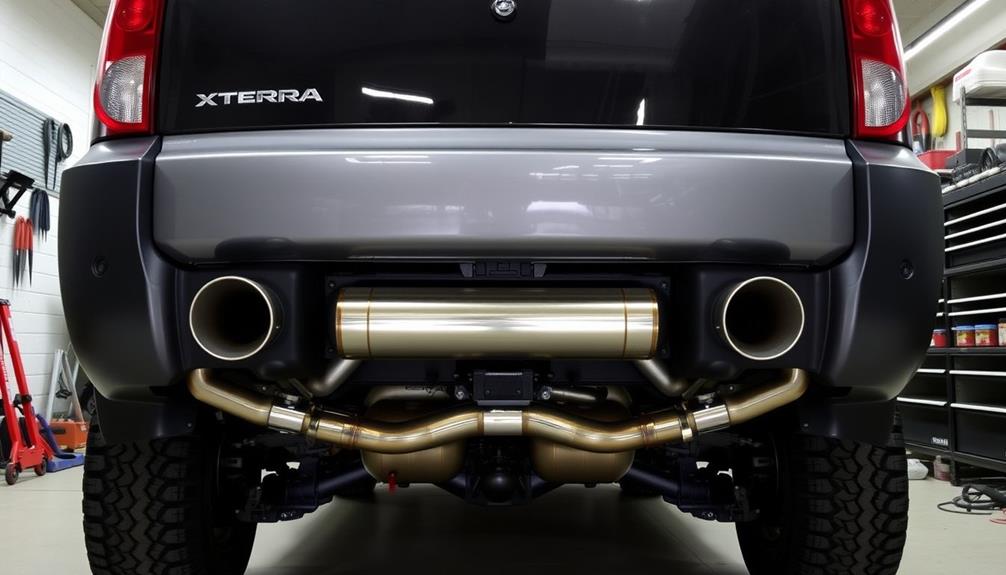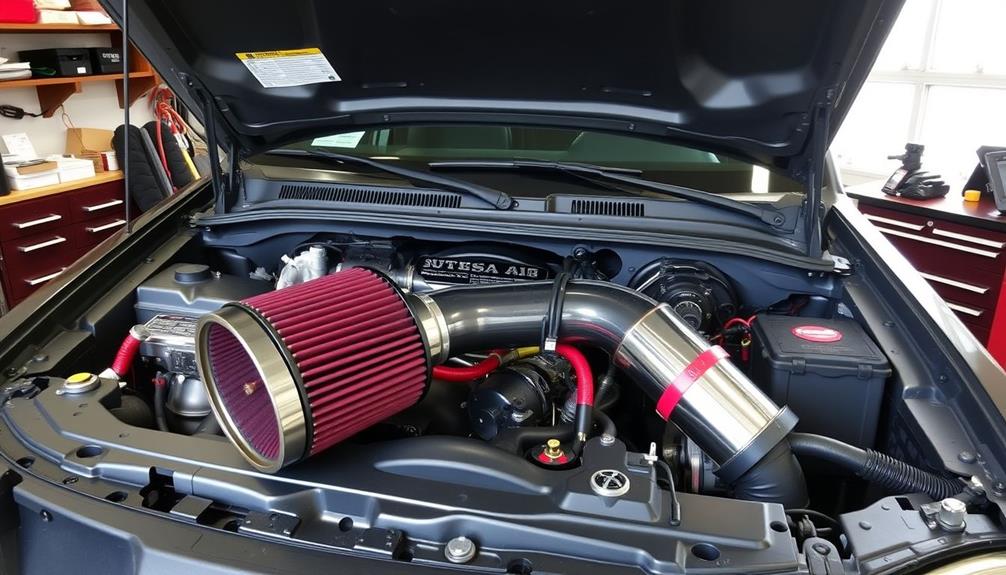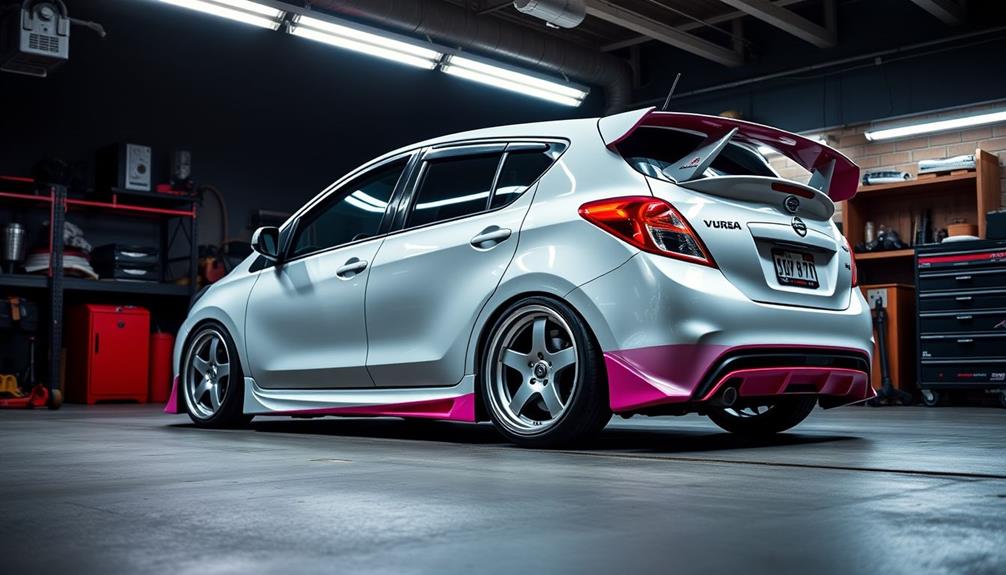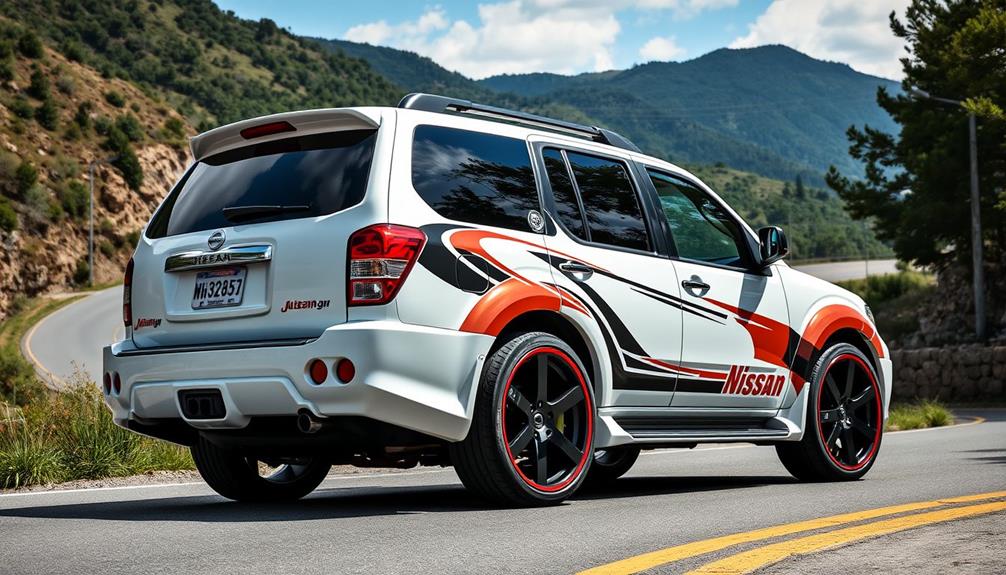Tuning your 2003 Nissan Xterra can greatly enhance its power and efficiency, turning your SUV into a more responsive ride. Start by upgrading the intake system with a cold air intake, which can boost horsepower by up to 10% and improve fuel economy. Pair that with a quality cat-back exhaust to optimize airflow and sound. Consider performance chips or a custom tune from UpRev to maximize throttle response and power. With just a bit of investment, you could see impressive gains. There's a wealth of insights and tips available to help you make the most of your tuning journey.
Key Takeaways
- Upgrading to a cold air intake (CAI) can boost horsepower and torque by up to 10%, enhancing overall engine performance.
- Installing an intake manifold spacer (IMS) improves air density and increases torque at lower RPMs, ideal for daily driving.
- A quality cat-back exhaust system improves airflow and sound quality, further increasing performance when combined with intake upgrades.
- Custom tuning with UpRev removes throttle restrictions, significantly enhancing power and efficiency, especially after extensive modifications.
- Budget-friendly performance chip modules can enhance throttle response and horsepower, providing an accessible option for tuning your Xterra.
Performance Modifications Overview
When it comes to tuning your 2003 Nissan Xterra, performance modifications can considerably enhance your driving experience.
You'll want to look at upgrades like cold air intakes (CAI) and intake manifold spacers (IMS) to boost horsepower and torque. These mild to modest modifications can yield peak gains of around 8 horsepower at 5600 rpm, making your Xterra feel more responsive on the road.
Custom performance tunes, such as those from UpRev, can release your vehicle's potential by removing throttle restrictions, further improving throttle response.
This means not only do you get more power, but your SUV will react quicker to your commands. While these upgrades can be budget-friendly, keep in mind that noticeable gains often require an investment exceeding $1,000, including installation costs.
Exhaust System Enhancements

Upgrading the exhaust system can be a game-changer for your 2003 Nissan Xterra, complementing the performance gains from intake modifications. A quality cat-back exhaust system, like the Doug Thorley exhaust, not only enhances power but also improves sound quality.
Its stainless steel construction and mandrel bends guarantee better airflow, which translates to increased performance.
For a more tailored fit and sound management, consider a custom exhaust installation using the Dynomax VT muffler. This system adjusts the valve based on exhaust pressure, optimizing performance under various driving conditions.
Remember, proper installation is essential—quality welding and alignment of exhaust components can greatly impact your performance gains.
The combination of intake and exhaust modifications can yield an impressive power increase of up to 31 horsepower and 34 lb-ft of torque, making these upgrades particularly effective.
The DT Cat Back system stands out for delivering both performance improvements and a desirable sound profile, thanks to its well-designed muffler specifications.
Investing in these exhaust enhancements not only boosts your Xterra's power but also elevates your driving experience.
Intake System Upgrades

When you upgrade your Nissan Xterra's intake system, you're setting the stage for enhanced performance.
A Volant Cold Air Intake can boost horsepower and improve throttle response, while an Intake Manifold Spacer offers a cost-effective way to increase torque.
These upgrades not only optimize airflow but can also lead to better fuel efficiency, making them smart additions to your tuning project.
Cold Air Intake Benefits
A cold air intake (CAI) system can greatly enhance your Nissan Xterra's performance by improving airflow to the engine.
By upgrading to a CAI, you can experience significant benefits that directly impact your driving experience. Here are three key advantages:
- Increased Engine Performance: Many CAI systems can boost horsepower and torque by up to 10%. This enhanced airflow leads to more power, making your Xterra feel more responsive on the road.
- Improved Fuel Economy: With better airflow, the engine can operate more efficiently, which may result in improved fuel economy. You'll get more miles out of every gallon, saving you money at the pump.
- Enhanced Throttle Response: A CAI allows your engine to breathe better, leading to quicker throttle response. You'll notice a more immediate reaction when you press the gas pedal, making your driving experience more engaging.
Consider the Volant CAI model #12740 for its full sealing design that reduces noise while improving air density.
Intake Manifold Spacer Advantages
After enhancing your Nissan Xterra's performance with a cold air intake, consider adding an intake manifold spacer (IMS) for even greater gains. The IMS is a cost-effective modification that improves throttle response and increases power at high RPMs by lengthening the intake runners, which boosts air volume and density. Users report peak gains of approximately 8 horsepower at 5600 RPM, resulting in a more responsive driving experience.
Here's a quick overview of IMS advantages:
| Advantage | Description | Benefits |
|---|---|---|
| Increased Airflow | Lengthens intake runners to improve air density | Enhances combustion efficiency |
| Better Throttle Response | Allows for quicker engine response | Improved driving experience |
| Cost-Effective Upgrade | Installation typically costs around $200 | Affordable performance boost |
| Enhanced Low-End Torque | Increases torque at lower RPMs | Better performance for daily driving |
With straightforward installation, the IMS is an ideal starting point for enthusiasts looking to tune performance without diving into complex modifications. Adding an IMS can make your Xterra not just more powerful but also more enjoyable to drive.
Tuning Options Available

When it comes to tuning your 2003 Nissan Xterra, you've got some solid options to explore.
Performance chip modules can reveal hidden power, while custom tuning solutions allow for tailored adjustments that fit your specific needs.
Don't forget about voltage stabilization benefits; they can enhance your vehicle's overall performance and reliability.
Performance Chip Modules
Releasing your Nissan Xterra 2003's true potential is easier than ever with a variety of performance chip modules.
These modules are designed to reveal hidden engine performance while ensuring safety and efficiency.
Here's a quick breakdown of the top options available:
- Stage 1 Module ($99.99): This entry-level option utilizes advanced OBD-2 technology to bolster your throttle body response and unleash extra horsepower.
- Stage 2 Module ($149.99): Designed for those who want enhanced performance, it delivers a money-back guarantee and promises improved fuel savings of up to 3 mpg.
- Stage 3 Module ($229.95): With a multi-core CPU, this advanced module maximizes performance without compromising safety, allowing for an exhilarating driving experience.
These performance chip modules not only improve your Nissan Xterra's horsepower and torque but also enhance overall responsiveness, making it an excellent choice for both on-road and off-road adventures.
Whether you're looking to increase power or achieve better fuel efficiency, these tuning options can greatly transform your driving experience.
Custom Tuning Solutions
Custom tuning solutions for your 2003 Nissan Xterra can dramatically enhance its performance, especially if you're planning extensive modifications. UpRev stands out as the primary option, effectively removing throttle restrictions and fine-tuning engine parameters for improved power and efficiency.
If you're looking for significant gains, this custom tuning can be a game changer.
While popular standard tuning options like Bullydog and Hypermax exist, they mightn't fully release your Xterra's potential. If you want to maximize performance, particularly with modifications like an intake manifold spacer or cold air intake, custom tuning is your best bet.
With dyno tests showing increases of around 30 hp under ideal conditions, you'll appreciate the difference.
The cost for UpRev tuning is approximately $500, which includes enhanced diagnostics for airbag and body control systems, alongside engine performance improvements.
You can also explore eTune options, available through email or in-person sessions at licensed shops, giving you flexibility in how you want to tune.
Whether you're a serious enthusiast or just want better performance from your Naturally Aspirated Xterra, working with a skilled tuner can help you achieve your goals.
Voltage Stabilization Benefits
After boosting your 2003 Nissan Xterra's performance with custom tuning, consider the benefits of voltage stabilization devices to further enhance your driving experience.
These devices play an essential role in maintaining consistent voltage levels, which is vital for peak truck performance. For Xterra owners looking to improve reliability and efficiency, here are three key advantages:
- Improved Stability: Voltage stabilization devices, like the Mega Raizin Module, guarantee your engine receives reliable power. This stability is especially beneficial during performance tuning and modifications.
- Enhanced Fuel Economy: Modules such as the D1 SPEC not only stabilize voltage but also improve fuel efficiency. This means you can enjoy better mileage while experiencing enhanced overall vehicle performance.
- User-Friendly Installation: Installing these voltage modules is straightforward and requires no cutting. This ease of integration allows for a hassle-free upgrade, making it accessible for all Xterra owners.
Community Insights and Experiences

When diving into the world of Nissan Xterra tuning, you'll find that community insights and experiences play an essential role in shaping your modifications journey. Forums like Club Xterra are treasure troves of shared advice on performance modifications, providing you with real-world feedback from fellow enthusiasts.
Many users report noticeable power gains, with dyno tests showing that combined intake and exhaust upgrades can yield around 31 horsepower and 34 torque increase.
You'll often hear from enthusiasts who advocate for patience, highlighting that while tuning can enhance your SUV's performance, the Xterra isn't meant to be a race car.
Basic modifications, like K&N drop-in filters and exhaust upgrades, are frequently discussed for their effectiveness in boosting air intake efficiency without breaking the bank.
The community sentiment balances the excitement of performance enhancements with a recognition of the Xterra's inherent characteristics. This perspective will help you navigate your tuning journey more effectively, ensuring that you enjoy the driving experience while achieving the performance improvements you desire.
Embrace these community insights as you explore the possibilities for your Nissan Xterra!
Cost Analysis and Budgeting

Tuning your 2003 Nissan Xterra can be an exciting yet financially demanding journey.
To effectively navigate this process, conducting a thorough cost analysis and careful budgeting is essential. Initial performance modifications can start at around $1,000, including upgrades like cold air intake systems and exhaust enhancements. Custom tuning through services like UpRev is another significant investment, costing approximately $500, to maximize your modifications' benefits.
Here are three key expenses to take into account in your budget:
- Performance Modifications: Expect to spend about $1,000 on initial upgrades.
- Installation Costs: Modifications such as the intake manifold spacer (IMS) and cold air intake (CAI) typically run around $200 each.
- Performance Chip Modules: Look for budget-friendly options, like the Stage 1 Module, which may drop from $149.99 to $99.99.
When you account for these costs, your total investment in performance upgrades can easily exceed $1,000, especially when including labor and additional components.
Frequently Asked Questions
What Are Common Problems With 2003 Xterra?
When owning a 2003 Xterra, you might face issues like rust, rear differential failure, engine misfires, transmission slipping, and a malfunctioning fuel gauge. Addressing these problems promptly can help maintain your SUV's performance and reliability.
What Is the Common Problem of Nissan Xterra?
You'll often find that Nissan Xterra owners face common problems like rust in the frame, rear axle issues, transmission shifting troubles, electrical malfunctions, and inaccurate fuel gauges, all of which can affect your driving experience.
How Much Horsepower Does a 2003 Nissan Xterra Supercharged Have?
Imagine releasing a beast! When you supercharge a 2003 Xterra, you can boost its horsepower by an impressive 50-70. That means your SUV roars with power, transforming your driving experience into pure exhilaration!
How Much Horsepower Does a Nissan Xterra 4.0 V6 Have?
The Nissan Xterra's 4.0L V6 engine produces about 265 horsepower at 5,600 RPM. You'll appreciate its strong performance, especially with peak torque around 284 lb-ft, making it ideal for off-roading and towing.
Conclusion
To sum up, tuning your 2003 Nissan Xterra can greatly boost both power and efficiency, making your SUV even more enjoyable to drive. Did you know that a well-tuned vehicle can improve fuel economy by up to 15%? That means not only are you enhancing performance, but you’re also saving money at the pump. By investing in the right modifications, you’re not just upgrading your ride; you’re also contributing to a greener environment. Happy tuning! And speaking of tuning, don’t forget to consider Nissan Pathfinder tuning as well. Many of the same modifications that can improve the performance and efficiency of the Xterra can also be applied to the Pathfinder. By optimizing the engine, exhaust, and intake systems, you can transform your SUV into a powerhouse on the road. So, whether you’re driving the Xterra or the Pathfinder, be sure to explore the options for tuning and customization to maximize your driving experience.










